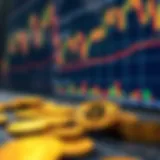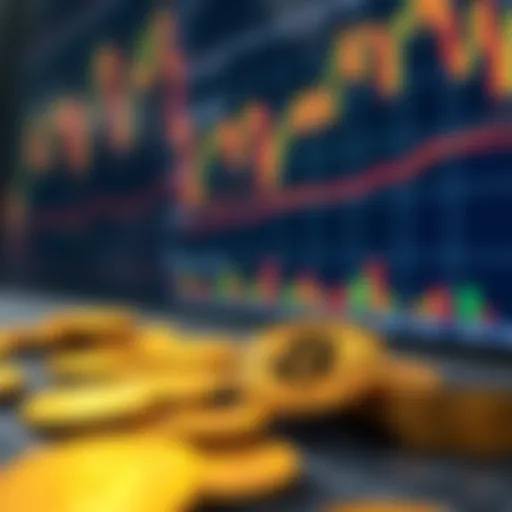Understanding Curve Exchange: A Deep Dive into DeFi


Intro
In the evolving realm of decentralized finance (DeFi), Curve Exchange stands out as a distinctive platform tailored primarily for stablecoin trading. It's not just another exchange; it’s designed with a specific purpose in mind, allowing users to swap stablecoins with minimal price impact. This functionality is vital, especially in a market where volatility in currencies can lead to significant losses for investors.
As the DeFi ecosystem continues to mature, understanding the nuances of Curve Exchange becomes increasingly important for anyone looking to navigate this dynamic space effectively. This article will delve into the operational mechanics behind Curve, its algorithmic design, the importance of liquidity pools, and much more.
Market Trends and Analysis
Market dynamics within DeFi are often driven by several factors, such as user demand, technological advancements, regulatory frameworks, and the ever-fluctuating state of cryptocurrencies.
Current Market Overview
Curve Exchange has carved a niche in the crowded exchange market. Unlike more generalized platforms that facilitate a wide array of tokens, Curve specializes in stablecoins. Its unique approach allows users to engage in swaps with much lower fees and reduced slippage. As of now, the platform has become a hub for liquidity, bringing together different stablecoins and giving traders numerous options. Notably, the total value locked (TVL) in Curve Exchange often reflects consumer confidence and the utility it offers.
Key Indicators and Metrics
Understanding performance comes down to several important metrics:
- Total Value Locked (TVL): Indicates the amount of capital currently staked in the platform; a critical success factor.
- Monthly Trading Volume: Represents the level of market activity on Curve, showing how often users engage with the platform.
- Liquidity Pool Depth: Provides insight into how much of a particular stablecoin is available for trading, directly affecting slippage rates.
All these indicators work together to depict a comprehensive picture of Curve Exchange’s standing in the DeFi market. Tracking these metrics consistently can provide investors with a keen understanding of when and how to engage with the platform.
Investment Strategies
Investing in DeFi, particularly through platforms like Curve, requires a thoughtful approach. Without a strategic plan, the risks can outweigh the rewards. While substantial profits await, they come hand-in-hand with volatility.
Long-term vs Short-term Strategies
Both strategies have their merits in the context of Curve Exchange.
- Long-term Investments: Ideal for those looking to hold stablecoins for the long haul while participating in liquidity pools. Holding a stable asset minimizes risk while potentially earning yield through the liquidity incentives offered by Curve.
- Short-term Trading: For those with a finger on the pulse of the market, taking advantage of price fluctuations can yield quick profits, albeit with increased risk. Traders should stay alert to market trends and be prepared for rapid execution.
Risk Management Techniques
No investment strategy is without risks. Effective risk management is crucial:
- Diversification: Don’t put all your eggs in one basket. Engage with a range of assets for better security against market shocks.
- Setting Stop-Loss Orders: Establish points at which you will exit a position to protect against losses should the market turn against you.
- Regular Monitoring: Keep a watchful eye on both market trends and regulatory changes affecting DeFi.
"Success in DeFi doesn't just boil down to choosing the right platform; it often hinges on strategic forethought, careful management, and an adaptability to the ever-shifting landscape."
These investment insights will help traders and investors understand how to navigate Curve Exchange, maximizing potential while minimizing pitfalls. As the DeFi terrain continues to unfold, staying informed about Curve's developments is essential for anyone vested in the future of digital finance.
Preface to Curve Exchange
The introduction of Curve Exchange delves into why this platform stands as a cornerstone in the decentralized finance (DeFi) space, particularly for stablecoin transactions. Understanding Curve is essential not just for users but also for investors and analysts who are striving to grasp the finer points of crypto trading dynamics.
Curve Exchange operates in a rather unique sector within DeFi that emphasizes stablecoins, crucial for reducing volatility in an otherwise unpredictable market. This importance lies in the fact that stablecoins act as a bridge between fiat currencies and the crypto domain, allowing traders to maneuver with relative assurance.
Thus, Curve’s design specifically optimized for stablecoin swaps can save users a pretty penny in transaction costs and mitigate the typical slippage seen in traditional exchanges. Given the rapid appreciation of stablecoins’ market cap, understanding Curve's mechanisms is paramount for anyone involved in the realm of crypto trading.
Understanding Decentralized Finance
Decentralized Finance, or DeFi for short, represents a transformative movement within the blockchain space that seeks to replicate traditional financial systems using smart contracts on blockchain platforms. This structure minimizes reliance on centralized institutions like banks and exchanges, which can often impose hefty fees and restrictions.
In essence, DeFi offers users total control over their assets. Individuals can lend, borrow, or trade directly with one another without intermediaries, which significantly enhances both efficiency and accessibility. The rise of DeFi has fostered capital movement at unprecedented scales, opening avenues for innovation and financial inclusion.
Furthermore, this ecosystem introduces novel financial products, ranging from yield farming to liquidity provision. Consequently, the landscape is rife with possibilities, although it does come bundled with its own sets of risks, making it critical for investors to gauge their involvement prudently.
The Need for Specialized Exchanges
In the constantly evolving landscape of cryptocurrency trading, specialized exchanges emerge as significant players. They cater to specific asset classes or user needs, diverging from general exchanges that often try to do it all. Curve Exchange is a prime example, engineering its architecture to excel in stablecoin swaps. This focus alleviates a lot of issues users face on broader platforms, particularly regarding slippage and transaction efficiency.
With specialized exchanges like Curve, users can enjoy benefits such as:
- Lower Fees: Intermediaries are reduced, which typically translates to lower transaction costs.
- Quicker Transactions: Designed for specific operations, these exchanges allow for swifter trades without hiccups associated with broader platforms.
- Tailored Services: Feature sets can cater precisely to the needs of liquidity providers and traders focused on stablecoins.
In summary, specialized exchanges fulfill the demand for more finely-tuned trading operations. They foster a user-centric ecosystem that can significantly improve the trading experience. Ignoring this trend could set traders and investors back in an industry moving at the speed of a runaway freight train.


Mechanics of Curve Exchange
Understanding the mechanics of Curve Exchange is crucial for grasping how it effectively enables stablecoin trading within the decentralized finance (DeFi) space. The mechanisms at play not only facilitate efficient transactions but also enhance user experience and investor confidence. By diving into the details of stablecoin swaps, the role of automated market makers, and liquidity pools, one can appreciate Curve's design philosophy and operational efficacy.
Stablecoin Swaps Explained
Stablecoin swaps are at the heart of what makes Curve Exchange distinct. In stark contrast to traditional exchanges, where price slippage can be a considerable concern, Curve leverages its specialized design to minimize these risks during the exchange process.
The mechanics of stablecoin swaps in Curve rely heavily on liquidity pools that are tailored for various stablecoin pairs. For example, swapping between DAI and USDC within the platform is not just a simple trade; it’s efficiently calculated so that users benefit from favorable rates with minimal deviation from the market price.
Additionally, the use of stablecoins, which are pegged to fiat currencies, diminishes volatility, leading to more predictable transaction outcomes. This is a notable advantage for investors who wish to maintain their asset values without exposure to the wild fluctuations often seen in other cryptocurrencies.
The Role of Automated Market Makers
Automated Market Makers (AMMs) are pivotal to the functionality of Curve Exchange. Unlike traditional market models that rely on order books, Curve uses AMMs to create a fluid market environment where trades can occur seamlessly without the need for buyers and sellers to match directly.
This mechanism employs algorithmically driven formulas to help determine asset pricing based on the available liquidity in each pool. The essence of AMMs is that they enable users to trade with virtually any amount of tokens they possess, without waiting for appropriate market conditions or counterparties.
One significant advantage is that liquidity providers earn a share of the transaction fees, making it an enticing prospect for those willing to contribute their assets to the liquidity pools. In turn, this incentivizes more participants, thus ensuring that liquidity remains high and trades can happen with ease.
Liquidity Pools and Their Functionality
Liquidity pools are essential components within the Curve framework. They store a combination of assets that users can draw upon for their trading needs. The function of these pools isn't merely to provide available balances; they directly influence the price effectiveness and slippage encountered during trades.
Each pool is created with a specific purpose in mind, often tailored for a set pair of stablecoins, such as USDT and Tether Gold. These pools allow users to supply these assets and earn returns through the transaction fees accrued in their usage. This effectively forms a circular benefit; as more liquidity is added, it enhances trading capability, thereby attracting even more users to the platform.
Furthermore, the dynamic nature of these pools means they are constantly adapting to user behavior and market conditions. This equilibrium fosters an environment where trades can be executed efficiently and effectively, drastically improving the overall liquidity within the DeFi landscape.
"In decentralized finance, the fluidity and efficiency of trading platforms like Curve Exchange redefine investment approaches, making the previously unattainable, attainable."
In summary, the mechanics of Curve Exchange are sophisticated yet fundamentally designed to benefit users seeking stablecoin swaps. The interplay between stablecoins, AMMs, and liquidity pools illustrates a well-rounded ecosystem where trading is not just an event but part of a larger financial strategy. Each element works synergistically, reinforcing Curve's significance in the DeFi landscape.
Core Algorithms Behind Curve Exchange
The backbone of Curve Exchange's efficiency and functionality lies in its core algorithms. These mathematical constructs not only dictate the trading experience but also enhance the stability of swaps between stablecoins. The algorithms adopted by Curve are key to understanding its operational brilliance, setting it apart in a crowded DeFi landscape where numerous exchanges vie for user attention.
Mathematical Models for Efficiency
At the heart of Curve's mechanics are advanced mathematical models. These models are designed to facilitate efficient trades while minimizing impermanent loss, a common pitfall for liquidity providers in decentralized exchanges. The core algorithm often utilized is known as the StableSwap invariant, which differs from traditional Constant Product Market Makers. It allows for deeper liquidity and tighter spreads between assets, which is crucial when trading stablecoins.
The beauty of this model lies in its ability to maintain a low slippage during transactions, making it incredibly appealing for traders who require quick executions at predictable prices. When trades occur, this model ensures that liquidity remains accessible, while reducing the cost incurred by slippage.
As a result, Curve realizes an efficient marketplace where users can seamlessly swap between various stablecoins all without facing the typical challenges of volatility or price discrepancies found elsewhere. This not only increases user satisfaction but also attracts active liquidity providers keen on earning fees from these well-structured trades.
Comparative Analysis with Other Platforms
When contrasting Curve Exchange's algorithms with other decentralized finance platforms, several distinctions become evident. Traditional exchanges like Uniswap utilize a constant product model which maintains proportional relationships between pairs but, in practice, leads to higher slippage and impermanent loss during stablecoin swaps. This comparison underscores Curve's superiority in handling stable assets where price stability is paramount.
Several notable aspects set Curve apart:
- Cost Efficiency: While many platforms incur higher transaction costs due to volatility handling, Curve operates with minimal fees, enhancing trading profitability.
- Liquidity Depth: The specialized algorithms foster deeper liquidity pools for stablecoins, yielding better prices and reducing the occurrences of slippage during considerable trades.
- Targeted User Base: By focusing mainly on stablecoin swaps, Curve tailors its trading dynamics to a specific audience, offering them a niche that is often overlooked in other exchanges.
Ultimately, by embracing mathematical rigor and practical consideration, Curve showcases not just an innovative approach but also a template for the future of stablecoin trading protocols in the burgeoning DeFi sector.
User Interaction with Curve Exchange
Understanding how users interact with Curve Exchange is fundamental for grasping its significance in the decentralized finance (DeFi) landscape. A platform designed for efficiency in stablecoin trading, it puts a strong emphasis on usability. For both seasoned investors and newcomers, interaction with the exchange can dictate an overall experience. Getting the hang of its interface and comprehending the costs involved can significantly affect trading outcomes.
Navigating the Interface
The interface of Curve Exchange is purposely designed to be intuitive, ensuring that every user can navigate through it without feeling overwhelmed. When logging in, users are greeted by a clean layout, which breaks down information into digestible sections. The dashboard prominently displays key metrics, such as current prices, liquidity pool status, and swap rates, aiding in quick, informed decisions.
Menu items are logically categorized, making them easily reachable. The design promotes ease of use, allowing users to switch between various stablecoins effortlessly. Menus for transaction history, liquidity management, and governance participation are also straightforward. For anyone accustomed to outdated exchanges, Curve can seem like a breath of fresh air. There are minimal distractions, so users can focus on executing trades without missteps.
Moreover, the platform accommodates different levels of expertise. Folks who are not deeply entrenched in crypto culture can find helpful guides and tooltips explaining functionalities. This user-friendly design not only enhances engagement but also fosters confidence among users, encouraging participation in an otherwise complex domain.
Understanding Fees and Costs
Fees form an essential aspect of any trading platform, influencing user behavior and trading strategies. Curve Exchange operates on a relatively transparent fee structure, which can be advantageous for users who are keen on maximizing their returns.


- Transaction Fees: When executing swaps, users typically pay a transaction fee. This fee can vary based on the liquidity pool being utilized. Understanding these fees is crucial, as they eat into profits particularly for high-volume traders.
- Slippage: Additionally, slippage may occur. This refers to the difference between the expected price of a trade and the actual price at which it is executed. In the dynamic environment of Curve, where stablecoins are traded, slippage should always be part of the calculations to avoid unintended disadvantages.
- Liquidity Provider Rewards: Users who contribute liquidity to pools may earn rewards in CRV tokens. This becomes an integral part of the financial equation, where fees earned can offset the costs of trading.
A clear understanding of these expenses empowers users to make better decisions, thereby increasing their overall experience with Curve Exchange. Notably, investors who take the time to dissect their fee structure often employ more refined strategies, resulting in optimized trading actions.
"Understanding user interaction is not just about knowing where to click—it's about comprehending the costs and choices that shape the trading landscape."
By navigating the interface judiciously and comprehending associated costs, users of Curve Exchange can effectively position themselves in the ever-evolving arena of DeFi. This knowledge not only enhances user experience, but also reinforces a sense of agency that is paramount in decentralized platforms.
The Role of Governance in Curve Exchange
Governance plays a crucial role in decentralized finance, especially within platforms like Curve Exchange. Unlike traditional financial systems that rely on centralized decision-makers, Curve Exchange empowers its community of users to shape the protocol's future. This participatory framework fosters innovation and resilience, ensuring that the platform can adapt to the ever-evolving landscape of DeFi.
One of the defining features of governance in Curve Exchange is the reliance on CRV tokens, which facilitate voting and decision-making processes. Holders of these tokens wield significant influence over protocol parameters, upgrades, and community initiatives. This shift away from top-down governance exemplifies how decentralized systems can prioritize user interests.
Community Involvement in Decision Making
At the heart of Curve's governance is the emphasis on community involvement in decision-making. This is not just a buzzword; it reflects a well-structured system where stakeholders have a direct say in changes that affect the platform. Participating as a CRV token holder provides users with the ability to propose modifications, from altering liquidity incentives to implementing new features or even changing smart contract parameters.
The voting process is designed to be transparent and accessible. Every proposal is laid out for the community to review and discuss before being put to a vote. This dialogue promotes collective intelligence, as members can voice insights and concerns, leading to well-informed decisions. The outcome is often a blend of diverse opinions, creating a solution that reflects the community's needs.
"Decentralization is about community, not just technology. Governance systems enable us to maintain that spirit."
However, with this power comes responsibility. Community members must stay informed about the implications of their votes. The nuances of proposal outcomes might not be immediately clear and can have ripple effects on the ecosystem.
Impact of CRV Token on Ecosystem
The CRV token stands at the center of Curve Exchange's governance. Its role extends beyond just facilitating trading; it acts as a lifeblood for the community's decision-making framework. The token incentivizes not only participation but also long-term commitment to the protocol's stability and growth.
CRV tokens can be earned by liquidity providers, rewarding them for their contributions. This earning potential encourages active engagement; the more one participates, the more influence they hold. Such a model mitigates the risks associated with governance by ensuring that those who are most invested in the platform's success also hold a voice in its direction.
Furthermore, the successful execution of governance proposals often correlates with positive outcomes for the Curve ecosystem. Enhanced liquidity, improved trading efficiency, and a stronger community demonstrate the practical benefits of active governance. Recognizing these impacts, token holders are more likely to engage continually, creating a self-reinforcing cycle of participation and improvement.
In the grand scheme, the governance structure of Curve Exchange not only promotes transparency but also aligns community incentives with the platform's overall health. As Decentralized Finance continues to mature, the governance models that platforms like Curve adopt will likely serve as a benchmark for effective community-driven evolution in the sector.
Security Considerations
When diving into the world of decentralized finance (DeFi), security emerges as a cornerstone concern. With the rapid evolution of platforms like Curve Exchange, the necessity to address potential vulnerabilities cannot be overstated. Users and investors alike have a vested interest in understanding how to protect their assets while navigating through the intricacies of this innovative financial ecosystem.
Common Vulnerabilities in DeFi
DeFi platforms, though revolutionary, are not without their pitfalls. The realm is littered with various common vulnerabilities that can pose significant risks:
- Smart Contract Bugs: Errors in code can lead to unexpected behaviors or exploits. A notable example is the infamous "Reentrancy Attack," where a malicious contract repeatedly calls back into a vulnerable contract, draining funds before the initial transaction completes.
- Liquidity Risks: During instances of extreme market volatility, liquidity pools may not maintain expected pricing, leading to significant losses.
- Governance Risks: Many DeFi protocols employ governance tokens for decision-making. Inadequate governance mechanisms can result in decisions that negatively impact users.
This landscape presents a myriad of challenges that users must stay vigilant about. Engaging with the community and being aware of past incidents, like the hack of the Alpha Homora protocol in early 2021, can provide invaluable lessons on precaution.
Protocol Updates and Audits
Routine updates and thorough audits serve as the lifeline that ensures a DeFi protocol's security. Curve Exchange, in particular, emphasizes these aspects:
- Regular Protocol Audits: Engaging reputable auditing firms like Certik or Quantstamp allows for an objective analysis of the smart contract code, identifying potential weaknesses before they can be exploited. This is not mere window dressing; comprehensive audits can be the difference between security and insolvency for users.
- Frequent Protocol Updates: The ever-shifting dynamics of the DeFi space necessitate constant updates. Protocol updates can introduce critical patches to vulnerabilities, enhance performance, and implement community feedback. Curve Exchange has been known to rollout improvements based on user input and observed security events.
"In DeFi, staying ahead means recognizing the value of proactive measures over reactive responses."
Investors should monitor these updates closely. They often come with detailed changelogs, highlighting what vulnerabilities have been addressed and any new features introduced. Understanding these changes provides users with a clearer insight into the ongoing safety measures being undertaken by the platform.
In summary, a proactive approach toward security, encompassing awareness of vulnerabilities and the importance of proper audits and updates, is essential for any participant in the Curve Exchange ecosystem. Such attentiveness not only safeguards investment but also contributes to the ecosystem's health and longevity.
Competitive Landscape of DeFi
In the world of decentralized finance (DeFi), understanding the competitive landscape is crucial for stakeholders, be it investors, traders, or analysts. This environment is marked by rapid innovation and fierce competition where platforms jostle for market share. Curve Exchange, with its unique focus on stablecoins, finds itself navigating this dynamic ecosystem.
The DeFi landscape is not just about standalone platforms; it consists of a network of interrelated services. Each service can complement another, creating an intricate web of opportunities and challenges. This connectivity is vital. It means that decisions made by one platform can ripple across the entire ecosystem.
Positioning Against Competitors
Curve Exchange positions itself uniquely against its competitors. While many DeFi platforms cater to a diverse range of assets, Curve's laser focus on stablecoin trading gives it a distinct edge. By specializing in low-slippage transactions between stablecoins, it can provide improved pricing efficiency.
- Niche Focus: Curve’s concentration on stablecoins draws liquidity from users specifically interested in these assets, rather than risking capital in more volatile cryptocurrencies.
- Profit Metrics: The benefits of this specialization are reflected in various metrics, such as lower fees and better yield opportunities compared to general-purpose exchanges.
- Automated Market Makers (AMMs): Utilizing AMMs, Curve can maintain capital efficiency in a way that aligns closely with its specialized service offering. This tech-savvy approach keeps user experience smooth while ensuring liquidity remains accessible.


To maintain this competitive edge, Curve continuously analyzes the strategies and offerings of its closest rivals, ensuring it adapts quickly to market shifts. For instance, platforms like Uniswap and Balancer have made waves with unique trading mechanisms, meaning Curve has no choice but to innovate—or risk falling behind.
Collaborations and Partnerships
Collaboration in the DeFi space is another aspect that cannot be overlooked. Curve has formed strategic partnerships that enrich both its offerings and market presence. These collaborations often bring new technologies and liquidity sources into the ecosystem.
- Integration with Other Protocols: For example, partnerships with lending platforms like Aave allow users to leverage Curve pools for enhanced yield farming capabilities.
- Shared Liquidity: Collaborations with other DeFi projects facilitate shared liquidity pools, creating more robust trading environments while minimizing risks associated with low liquidity.
- Cross-Protocol Initiatives: These partnerships also open doors for cross-protocol initiatives, such as liquidity mining programs, expanding the user base and enhancing overall trading volumes.
Moreover, engaging in the broader DeFi community aids Curve Exchange in building a solid reputation. It’s not just about being a better option for stablecoin swaps, but about promoting a collaborative spirit that drives the entire sector forward.
The competitive landscape of DeFi remains in flux, influenced by technologies, partnerships, and market trends, making it essential for platforms like Curve Exchange to stay vigilant and adaptive.
Real-World Applications
In the constantly evolving landscape of decentralized finance, the real-world applications of Curve Exchange stand as a testament to its utility and versatility. This section dives into how Curve is shaping financial interactions and transforming traditional paradigms. By facilitating efficient stablecoin trading, Curve Exchange is not just a theoretical platform; it's actively participating in reshaping user experiences and institutional strategies.
Case Studies of Successful Implementations
Several notable case studies illustrate how Curve Exchange has found its niche and made an impact in diverse financial scenarios.
For instance, one such example involves Yearn Finance, which utilizes Curve's liquidity pools for optimal yield farming strategies. By routing user funds through Curve’s deep liquidity, Yearn is able to offer its users enhanced yield rates compared to conventional methods. This synergy exemplifies the potential of integrating stablecoin swaps into broader financial ecosystems.
Another case involves Synthetix, a derivatives trading platform that leverages Curve's ability to facilitate seamless stablecoin swaps. Users can easily convert their assets between different synthetic forms, thereby expanding their trading options while reducing slippage — a critical factor when operating in volatile markets.
The importance of such successful implementations cannot be understated; they not only showcase Curve's functionality but also provide tangible evidence of its growing relevance.
Evolving Use Cases in Finance
As time progresses, the applications of Curve Exchange continue to evolve and diversify. The ability to handle stablecoin swaps efficiently opens doors for various use cases that transcend basic trading. For instance, in the realm of cross-border transactions, Curve can streamline conversions between different fiat-backed stablecoins, maximizing liquidity and minimizing costs.
Furthermore, there’s an increasing interest in using Curve for decentralized lending protocols. Users can deposit stablecoins into Curve’s liquidity pools to serve as collateral, which in turn allows them to borrow against their assets. This not only enhances the usability of stablecoins but also fosters an environment where borrowers can access a broader spectrum of financing options.
In summary, the landscape of financial applications utilizing Curve Exchange is continuously expanding. With case studies underscoring successful collaborations and evolving use cases that address real-world financial challenges, Curve exemplifies a shift toward more integrated, efficient, and accessible decentralized finance solutions. By bridging the gap between traditional financial practices and innovative technologies, Curve Exchange solidifies its place as a cornerstone in DeFi.
The Future of Curve Exchange
The future trajectory of Curve Exchange is pivotal for enthusiasts and investors alike within the DeFi landscape. As the sector continues evolving at breakneck speed, Curve Exchange must innovate and adapt to maintain its competitive edge while addressing the growing needs of its user base. Understanding these future developments can offer insights not only into Curve’s strategies but also the broader implications for decentralized finance as a whole.
Upcoming Features and Innovations
One of the most exciting aspects of Curve Exchange's future is the potential introduction of new features and technological innovations. Curve is already renowned for its efficiency in stablecoin trading, but the advancement doesn’t end there. The integration of cross-chain capabilities could significantly enhance liquidity and user engagement.
- Cross-Chain Support: Expanding trading options to include various blockchains can lower barriers for users, allowing wider access to different stablecoins and increasing overall trading volume.
- Enhanced User Interface: Continuous improvements to the user interface will likely be key. As more novice users enter the DeFi space, having a streamlined, intuitive interface can make trading less daunting and more accessible.
- Advanced Analytics Tools: Tools that provide real-time analysis of trading trends and rewards could attract more sophisticated investors who seek to optimize their trading strategies.
These innovations represent not just technical enhancements but also a commitment to user experience. Without a doubt, if Curve Exchange successfully rolls out these upcoming features, it can solidify its place as a dominant player in the DeFi arena.
Long-Term Implications for the DeFi Sector
The prospects for Curve Exchange don’t just influence its operational framework; they also cast a long shadow on the entire DeFi ecosystem. As Curve continues to refine its offerings, other platforms will inevitably look to it for inspiration and benchmarks.
- Setting Industry Standards: As Curve Exchange introduces cutting-edge features, it sets standards that other platforms might adopt, fostering a more robust and credible DeFi landscape.
- Promoting Stability in DeFi: By focusing on efficient trading mechanisms, Curve can contribute to the stability of stablecoin markets. Reduced slippage and minimal impermanent loss will create a safer environment for investors, potentially bringing in traditional finance players.
- Interoperability: With the future leaning towards interconnected ecosystems, Curve’s focus on cross-chain functionality may lead to an overall push for interoperability among DeFi platforms. This could revolutionize how assets move across blockchains, unlocking liquidity in unprecedented ways.
"The adaptive nature of Curve Exchange reflects the rapidly changing tides of DeFi. Its future is not just about expanding its functionalities but also about redefining what is possible within decentralized finance."
The transformation of Curve Exchange will no doubt signal numerous changes across the spectrum of decentralized finance. Investors, traders, and analysts must keep a keen eye on these developments, as recognizing and understanding these trends early on could be the key to unlocking the potential gains within this cutting-edge space.
The End
The conclusion plays a critical role in any comprehensive article as it serves to encapsulate and reinforce the key insights discussed throughout. In the case of Curve Exchange and its impact on the decentralized finance landscape, the importance of this section cannot be overstated. Effectively summarizing the findings allows both seasoned investors and newcomers in the cryptocurrency space to appreciate the fundamental concepts that define the trading experience on the Curve platform.
Summarizing Key Findings
Through this exploration, we have discerned several pivotal elements regarding Curve Exchange:
- Stablecoin Efficiency: Curve's mechanics are designed specifically to execute stablecoin swaps efficiently, minimizing slippage and boosting overall trading effectiveness. This feature positions it as a preferential choice among platforms catering to stable assets.
- Automated Market Makers: The exchange employs innovative automated market makers that facilitate liquidity, making trading more seamless. Users could easily execute trades without relying heavily on traditional order book structures.
- Community Governance: Important decisions regarding updates and changes in Curve are driven by community involvement, particularly through the governance token, CRV. This decentralized approach fosters a more democratic environment, aligning the platform with the ethos of decentralized finance.
- Security and Protocol Integrity: A rigorous focus on security, through periodic audits and protocol updates, ensures that users can engage with trust, mitigating common vulnerabilities that plague many DeFi projects.
- Future Innovations: The constant iteration and enhancement of features signal a commitment to remaining at the forefront of the DeFi evolution, which is crucial for attracting and retaining users.
Reflecting on these findings reveals that Curve Exchange is not merely a tool for traders; it represents a significant movement in reshaping how individuals interact with their financial assets, all while maintaining a focus on efficiency and community.
Final Thoughts on Curve Exchange's Evolution
As we conclude this narrative on Curve Exchange, it is paramount to recognize its evolution thus far and where it might lead. The platform, while established as a major player in stablecoin trading, is still in a state of continuous development. The trends we have observed indicate that Curve has the potential to harness emerging technologies, enhance user experiences, and adapt its governance model further. With ever-increasing scrutiny on security practices and user needs, institutions and individuals alike are poised to expand their engagement with Curve Exchange.
In an ever-evolving DeFi landscape, both investors and analysts possess the critical responsibility of staying informed and flexible. Curve's ongoing commitment to innovation and user-centricity will shape its trajectory, influencing the larger decentralized financial ecosystem. Therefore, understanding Curve Exchange's mechanisms, community governance, and security paradigm is essential for anyone seeking to navigate and benefit from the future of finance.
"As Curve continues to adapt to the DeFi landscape, its sustained evolution represents a beacon of practicality and community-driven innovation in a rapidly changing world."
Looking ahead, it remains crucial for all stakeholders to witness Curve's continued journey not merely as consumers but as active participants in a revolution that challenges traditional financial norms.















